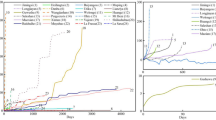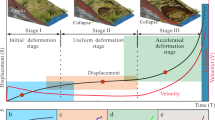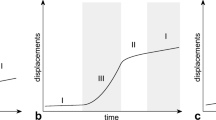Abstract
This paper presents a new framework for characterizing landslide deformation. Here, the deformation of a landslide is interpreted as a summation of three components: rigid deformation, within-mass deformation, and residual deformation. On the basis of the monitored data of the landslide deformation, these three components may be characterized separately: the rigid deformation is simulated by a summation of a trend term and a periodic term, the within-mass deformation is simulated by a high-order polynomial model, and the residual deformation is simulated by a conditional random field model. In particular, the characterization of the residual deformation, the third component of the landslide deformation, with the random field allows for a probabilistic assessment of the landslide deformation in the face of geological uncertainties. With the proposed framework, the evolution of landslide deformation in both geometric and time domains may be established, which allows for an assessment of the sliding mechanism of the landslide. Further, evolution in the geometric domain may allow for an assessment of the serviceability of infrastructures in the landslide area. To illustrate this new landslide deformation characterization framework, a case study of the Yu-Kai highway landslide in Guizhou, China is presented, through which the effectiveness of the proposed framework is demonstrated.


















Similar content being viewed by others
References
Acikgoz S, Soga K, Woodhams J (2017) Evaluation of the response of a vaulted masonry structure to differential settlements using point cloud data and limit analyses. Constr Build Mater 150:916–931
Ang AHS, Tang WH (2007) Probability concepts in engineering: emphasis on applications to civil and environmental engineering, 2nd edn. Wiley, New York
Arosio D, Longoni L, Papini M, Scaioni M, Zanzi L, Alba M (2009) Towards rockfall forecasting through observing deformations and listening to microseismic emissions. Nat Hazards Earth Syst Sci 9(4):1119–1131
Barla G, Antolini F, Barla M, Mensi E, Piovano G (2010) Monitoring of the Beauregard landslide (Aosta Valley, Italy) using advanced and conventional techniques. Eng Geol 116(3-4):218–235
Cai Z, Xu W, Meng Y, Shi C, Wang R (2016) Prediction of landslide displacement based on GA-LSSVM with multiple factors. Bull Eng Geol Environ 75(2):637–646
Carlà T, Intrieri E, Di Traglia F, Nolesini T, Gigli G, Casagli N (2017) Guidelines on the use of inverse velocity method as a tool for setting alarm thresholds and forecasting landslides and structure collapses. Landslides 14(2):517–534
Chen LX, Yin KL, Dai YX (2011) Building vulnerability evaluation in landslide deformation phase. J Mt Sci 8(2):286–295
Chen G, Zhu J, Qiang M, Gong W (2018) Three-dimensional site characterization with borehole data – a case study of Suzhou area. Eng Geol 234:65–82
Crosta GB, Agliardi F, Rivolta C, Alberti S, Dei Cas L (2017) Long-term evolution and early warning strategies for complex rockslides by real-time monitoring. Landslides 14(5):1615–1632
Cui P, Zhu YY, Han YS, Chen XQ, Zhuang JQ (2009) The 12 may Wenchuan earthquake-induced landslide lakes: distribution and preliminary risk evaluation. Landslides 6(3):209–223
Du J, Yin KL, Lacasse S (2013) Displacement prediction in colluvial landslides, three gorges reservoir, China. Landslides 10(2):203–218
Eftekhari A, Taromi M, Saeidi M (2014) Uncertainties and complexities of the geological model in slope stability: a case study of Sabzkuh tunnel. Int J Min Geol Eng 48(1):69–79
Fenton GA (1999) Estimation for stochastic soil models. J Geotech Geoenviron 125(6):470–485
Gong W, Tien YM, Juang CH, Martin JR, Luo Z (2017a) Optimization of site investigation program for improved statistical characterization of geotechnical property based on random field theory. Bull Eng Geol Environ 76(3):1021–1035
Gong W, Juang CH, Martin JR (2017b) A new framework for probabilistic analysis of the performance of a supported excavation in clay considering spatial variability. Géotechnique 67(6):546–552
Gong W, Juang CH, Martin JR II, Tang H, Wang Q, Huang H (2018) Probabilistic analysis of tunnel longitudinal performance based upon conditional random field simulation of soil properties. Tunn Undergr Space Technol 73:1–14
Greif V, Vlcko J (2012) Monitoring of post-failure landslide deformation by the PS-InSAR technique at Lubietova in Central Slovakia. Environ Earth Sci 66(6):1585–1595
Herrera G, Fernández-Merodo JA, Mulas J, Pastor M, Luzi G, Monserrat O (2009) A landslide forecasting model using ground based SAR data: the Portalet case study. Eng Geol 105(3-4):220–230
Hu XL, Zhang M, Sun MJ, Huang KX, Song YJ (2015) Deformation characteristics and failure mode of the Zhujiadian landslide in the three gorges reservoir, China. Bull Eng Geol Environ 74(1):1–12
Huang FM, Huang JS, Jiang SH, Zhou CB (2017) Landslide displacement prediction based on multivariate chaotic model and extreme learning machine. Eng Geol 218:173–186
Jiao YY, Zhang HQ, Tang HM, Zhang XL, Adoko AC, Tan HN (2014) Simulating the process of reservoir-impoundment-induced landslide using the extended DDA method. Eng Geol 182:37–48
Juang CH, Schuster M, Ou CY, Phoon KK (2011) Fully probabilistic framework for evaluating excavation-induced damage potential of adjacent buildings. J Geotech Geoenviron 137(2):130–139
Krkač M, Špoljarić D, Bernat S, Arbanas SM (2017) Method for prediction of landslide movements based on random forests. Landslides 14(3):947–960
Lee CT, Huang CC, Lee JF, Pan KL, Lin ML, Dong JJ (2008) Statistical approach to earthquake-induced landslide susceptibility. Eng Geol 100:43–58
Li XY, Zhang LM, Li JH (2015) Using conditioned random field to characterize the variability of geologic profiles. J Geotech Geoenviron 142(4):04015096
Luo Z, Atamturktur S, Cai YQ, Juang CH (2012) Simplified approach for reliability-based design against basal-heave failure in braced excavations considering spatial effect. J Geotech Geoenviron 138:441–450
Ma JW, Tang HM, Liu X, Hu XL, Sun MJ, Song YJ (2017) Establishment of a deformation forecasting model for a step-like landslide based on decision tree C5.0 and two-step cluster algorithms: a case study in the three gorges reservoir area, China. Landslides 14(3):1275–1281
Macfarlane DF (2009) Observations and predictions of the behaviour of large, slow-moving landslides in schist, Clyde dam reservoir, New Zealand. Eng Geol 109(1-2):5–15
Mansour MF, Morgenstern NR, Martin CD (2011) Expected damage from displacement of slow-moving slides. Landslides 8(1):117–131
Miao FS, Wu YP, Xie YH, Li YN (2017) Prediction of landslide displacement with step-like behavior based on multialgorithm optimization and a support vector regression model. Landslides:1-14
Ministry of Land and Resources (MLR) of the People’s Republic of China (2016) Zhongguo Guotu Ziyuan Gongbao 2015 (in Chinese). (http://www.mlr.gov.cn/zwgk/tjxx/201604/P020160421532279160618.pdf)
Mohammadi S, Taiebat H (2016) Finite element simulation of an excavation-triggered landslide using large deformation theory. Eng Geol 205:62–72
Parry S, Campbell SDG (2007) Deformation associated with a slow moving landslide, Tuen Mun, Hong Kong, China. Bull Eng Geol Environ 66(2):135–141
Pedrozzi G (2004) Triggering of landslides in canton Ticino (Switzerland) and prediction by the rainfall intensity and duration method. Bull Eng Geol Environ 63(4):281–291
Peduto D, Nicodemo G, Maccabiani J, Ferlisi S (2017) Multi-scale analysis of settlement-induced building damage using damage surveys and DInSAR data: a case study in the Netherlands. Eng Geol 218:117–133
Peyret M, Djamour Y, Rizza M, Ritz JF, Hurtrez JE (2008) Monitoring of the large slow Kahrod landslide in Alborz mountain range (Iran) by GPS and SAR interferometry. Eng Geol 100(3-4):131–141
Ranalli M, Gottardi G, Cetina ZM, Nadim F (2010) Uncertainty quantification in the calibration of a dynamic viscoplastic model of slow slope movements. Landslides 7(1):31–41
Ren F, Wu XL, Zhang KX, Niu RQ (2015) Application of wavelet analysis and a particle swarm-optimized support vector machine to predict the displacement of the Shuping landslide in the Three Gorges, China. Environ Earth Sci 73(8):4791–4804
Sasahara K (2017) Prediction of the shear deformation of a sandy model slope generated by rainfall based on the monitoring of the shear strain and the pore pressure in the slope. Eng Geol 224:75–86
Schöbi R, Sudret B (2015) Application of conditional random fields and sparse polynomial chaos expansions to geotechnical problems. In: Schweckendiek et al (eds) Geotechnical safety and risk V. IOS Press BV, Amsterdam, pp 445–450
Su MB, Chen IH, Liao CH (2009) Using TDR cables and GPS for landslide monitoring in high mountain area. J Geotech Geoenviron 135(8):1113–1121
Xiao J, Gong W, Martin JR II, Shen M, Luo Z (2016) Probabilistic seismic stability analysis of slope at a given site in a specified exposure time. Eng Geol 212:53–62
Zhang WG, Goh ATC (2013) Multivariate adaptive regression splines for analysis of geotechnical engineering systems. Comput Geotech 48:82–95
Zhang J, Zhang LM, Tang WH (2009) Bayesian framework for characterizing geotechnical model uncertainty. J Geotech Geoenviron 135(7):932–940
Zhu HH, Shi B, Yan JF, Zhang J, Wang J (2015) Investigation of the evolutionary process of a reinforced model slope using a fiber-optic monitoring network. Eng Geol 186:34–43
Acknowledgments
The financial support provided by the National Key R&D Program of China (No. 2017YFC1501304) and the National Natural Science Foundation of China (No. 41702294) is acknowledged. The authors also wish to thank Mr. Qun Li at the CCCC Second Highway Consultants Co. Ltd. for providing the monitoring data of the deformation of the Yu-Kai highway landslide and Mr. Wenqiang Liu at China University of Geosciences (Wuhan) for help collect the general information of the Yu-Kai highway landslide.
Author information
Authors and Affiliations
Corresponding author
Rights and permissions
About this article
Cite this article
Tang, H., Gong, W., Li, C. et al. A new framework for characterizing landslide deformation: a case study of the Yu-Kai highway landslide in Guizhou, China. Bull Eng Geol Environ 78, 4291–4309 (2019). https://doi.org/10.1007/s10064-018-1397-0
Received:
Accepted:
Published:
Issue Date:
DOI: https://doi.org/10.1007/s10064-018-1397-0




